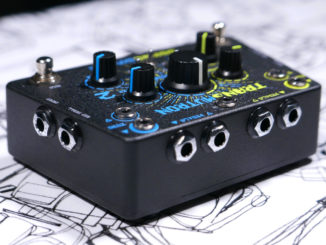Three new modules from ST-Modular: Duck brings simple sidechaining in Eurorack, a mono to stereo helper and a multi-functional gate toolbox.
When I reported on the radio, the cute little workmates and the feature-rich delay module Singer on February 1st, I thought ST-Modular was done with new announcements.
Thought wrong. Last week he pulled three more out of his hat. And again which are very helpful.
ST-Modular Duck
As the name suggests, Duck is a small but useful ducking or sidechaining module. It reduces the level of an audio signal when a CV/Gate signal is applied. This technique is useful if your sounds are hidden in an overcrowded and muddy mix. The module is layed out very simple: four parameters, a trigger & CV input and audio in/out. There is a trigger CV input yes, but according to the developer it’s not capable of creating slow duckings.
On the parameter side, you have amount knob that sets the overall effect of level reduction. Hold sets the length of level reduction when the gate signal at the gate input is high. Rise determines the amount of fade-in that’s applied to the level reduction, and Fall the amount of time the signal needs to fully recover from level reduction. Plus, you have two LED idicators.
ST-Modular Stereo Total
The ST-Modular Stereo Total is all about “stereofication”. The module combines a mono to stereo converter and stereo width controller & imager in one module. It consists of two blocks, a stereo simulator and a stereo width control. The stereo simulator creates a stereo signal from an mono signal by splitting the signal in two sperate signals. To achieve this, it uses a RC-network to reduce mid frequencies of the left channel and a operational amplifier for the right channel. The stereo depth knob gives you control over the depth of stereo but also of the stereo field.
An additional lossless copy of the mono signal is available on the mono output jackm that’s handy. The second block is a stereo width control that allows you to change a stereo signal from mono to wide stereo. Here, the module sums both signals (L/R) and create a mono singal fully-counter-clockwise and fully clockwise a stereo signal. The latter doesn’t contain any centre image at all says the developer. The module is not only the go-to tool for mono to stereo but also a helpful tool for processing stereo signals.
ST-Modular Cause & Effect
Cause & Effect consists of three different utility units in one module: a voltage reader, hold & a gate switch. The voltage reader outputs a signal according to a limit set with the read limit knob. If you reach your limit with the incoming voltage, the module will output a high gate in the R gate socket. This is also CV-controllable at the limit CV jack. Thanks to an internal normalization, you only need on signal to control all other units.
Hold has two modes: the first sample/store a voltage from the hold in jack and outputs it at the hold out jack if a gate at H gate is high. In another mode it can pass through the incoming voltage when gate is high. It then samples and stores the last voltage value applied when gate switches to low. The modes are selectable via the HOLD MODE switch. Last but not least we have the gate switch mode. As the name suggest, it switch gates according to the voltage level.
Duck, Stereo Toal & Cause & Effect, three neat helpers that ST-Modular shows us here. Lots of functionality in compact modules. The modules are again only available as a DIY project. Exact prices for kits, for PCBs … please check at the dealers.
More information here: ST-Modular





Be the first to comment